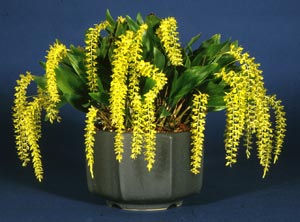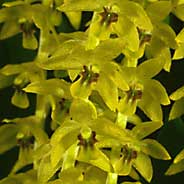
Dendrochilum uncatum
by Marni Turkel
| Hybrid Flask List |
| Orchid Programs |
 |
| Dendrochilum uncatum var. uncatum 'Stony Point' in a 6" pot |
If you like plants with a sculptural quality, the genus Dendrochilumis a good place to look. Of the 263 + species of Dendrochilum, some can have a rangy quality, but the majority are compact plants with closely spaced pseudobulbs. If you provide the basic cultural requirements, a plant can double in size each year and produce a free-blooming specimen plant in a short time.
In recent years, many species of Dendrochilum have come into general cultivation, thereby broadening the choices available to the hobbyist grower. Dendrochilum uncatum is a small-stature plant approximately 6 inches (15 cm) tall with dark green leathery leaves, which sends out arching spikes of yellow-green flowers from the emerging growth. It is native to Taiwan and the Philippines and is closely related to several other popular and widely grown species: Dendrochilum cobbianum, Dendrochilum filiforme and Dendrochilum magnum.
 |
| Dendrochilum uncatum var uncatum |
There are two varieties of Dendrochilum uncatum. The species epithet uncatum refers to the sickle-shaped or hooked arms attached to the column that is the defining characteristic between the two varieties. In D. uncatum var. longispicatum, the arms are attached on the bottom of the column, whereas, in D. uncatum var. uncatum, the arms are attached at the middle of the column. In the Philippines, D. uncatum grows on rocks and trees at elevations of 3,281 to 7,546 feet (1,000 to 2,300 m) with some reports as low as 1,640 feet (500 m). I grow it in a cool greenhouse with winter minimum nights of 52 F (11 C) and average days in the mid 70s (24 C), but it can also be grown in intermediate temperatures with winter minimum nights between 55 and 60 F (13 and 16 C).
A fine-grade epiphytic mix is good for potted plants. If you do not have a preferred mix of your own, try 80 percent washed and sifted fine fir bark and 20 percent medium perlite. Potted plants of the genus Dendrochilum do best when not over-potted.
For mounted plants, I recommend a horizontal mount, as D. uncatum can be found growing on large, almost horizontal branches. Grow it in moderately bright light with good humidity and air movement. Water plants year round and use half-strength fertilizer as for other orchids. Plants should be allowed to approach dryness between waterings.
Acknowledgments
I wish to thank Eric Christenson, PhD, for identifying this and many other plants for me as well as generously sharing information.
Mostly Species / Orchids and Flasks | Santa Rosa, CA 95407
© Marni Turkel 2003-2022 All rights reserved
